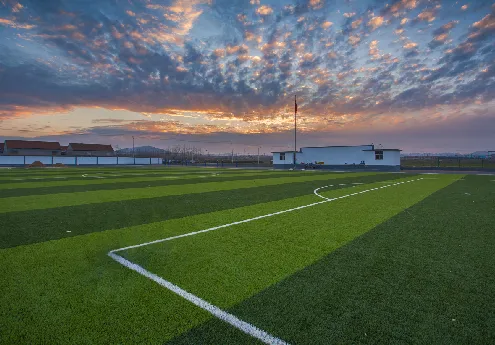
- Afrikaans
- Arabic
- Belarusian
- Bengali
- Czech
- Danish
- Dutch
- English
- Esperanto
- Estonian
- Finnish
- French
- German
- Greek
- Hindi
- Hungarian
- Icelandic
- Indonesian
- irish
- Italian
- Japanese
- kazakh
- Rwandese
- Korean
- Kyrgyz
- Lao
- Latin
- Latvian
- Malay
- Mongolian
- Myanmar
- Norwegian
- Persian
- Polish
- Portuguese
- Romanian
- Russian
- Serbian
- Spanish
- Swedish
- Tagalog
- Tajik
- Thai
- Turkish
- Turkmen
- Ukrainian
- Urdu
- Uighur
- Uzbek
- Vietnamese
artificial grass football field
Dec . 10, 2024 11:12 Back to list
The Rise of Artificial Grass Football Fields A Game Changer in Modern Sports
In recent years, the landscape of sports fields has undergone a significant transformation, with artificial grass football fields gaining immense popularity. These synthetic surfaces are revolutionizing the way football is played, offering a multitude of benefits that stand out in comparison to traditional natural grass pitches. As we delve into the reasons behind this shift, we can better appreciate the advantages and implications of artificial turf for the future of football.
Durability and Consistency
One of the primary advantages of artificial grass is its durability. Unlike natural grass, which can become worn, muddy, and uneven due to adverse weather conditions or heavy foot traffic, synthetic turf maintains its integrity regardless of climate. This consistency is particularly beneficial for football, where a uniform playing surface is crucial for optimal performance. Players can rely on a stable field, enabling them to make fast-paced movements without the risk of slipping or stumbling due to uneven ground.
The lifespan of artificial grass also surpasses that of natural grass. With proper maintenance, a synthetic field can last over a decade, reducing the need for frequent repairs or replanting. This longevity not only saves money in the long run but also provides consistent playing conditions throughout the season, enhancing the quality of gameplay.
Low Maintenance Costs
Maintaining a natural grass football field can be labor-intensive and costly. Regular upkeep requires mowing, watering, fertilizing, and pest control, not to mention the time invested in these activities. In contrast, artificial grass fields demand significantly less maintenance, allowing facility managers to allocate resources to other areas. With minimal upkeep, including periodic brushing and occasional infill replenishment, synthetic fields are a more economically viable option for schools, colleges, and recreational facilities.
Year-Round Playability
artificial grass football field

Another remarkable feature of artificial grass is its ability to withstand weather extremes. While natural grass can become unplayable in heavy rain or snow, artificial turf remains available for use in various conditions. This ensures that games and practices can continue year-round, providing athletes with more opportunities to develop their skills and maintain competitive performance. This increased accessibility is particularly important for youth sports programs, where consistent practice is vital for development.
Safety Considerations
Player safety is paramount in any sport. Artificial grass fields are designed to provide better shock absorption than traditional grass, reducing the risk of injuries such as sprains or concussions. Many synthetic pitches are made with advanced technology that enhances player safety, including shock pads and specific turf configurations that meet safety standards set by organizations like FIFA and the International Rugby Board. These innovations ensure that athletes can play in a safe environment, fostering confidence and improving overall performance.
Environmental Impact
While the production of artificial grass does have environmental considerations, modern advancements have made strides towards creating more sustainable options. Many manufacturers now offer eco-friendly synthetic turf that utilizes recycled materials and is designed to minimize environmental impact. Furthermore, artificial grass eliminates the need for watering, chemical fertilizers, and pesticides, collectively conserving water and reducing chemical runoff into the ecosystem. This pivot towards sustainability makes artificial grass an appealing choice for environmentally conscious teams and municipalities.
Conclusion
The adoption of artificial grass football fields marks a significant advancement in the world of sports. With remarkable durability, low maintenance costs, year-round playability, and enhanced safety features, synthetic turf is quickly becoming the preferred choice for football programs at all levels. As technology continues to evolve, we can expect even more improvements in the quality and sustainability of artificial grass. Ultimately, this evolution not only enhances the experience for players and coaches but also signifies a broader shift towards innovation and sustainability in the realm of sports. Embracing artificial grass fields might very well be one of the most influential decisions in the future of football.
-
The Benefits of Artificial Turf for Indoors
NewsJul.15,2025
-
How Artificial Grass Suppliers Ensure Quality Products
NewsJul.15,2025
-
Artificial Grass and Pets: A Space for Relaxation
NewsJul.08,2025
-
Balcony & Outdoor Decoration with Artificial Grass
NewsJul.08,2025
-
Best Indoor Artificial Grass for Home
NewsJul.07,2025
-
Best Pet Turf for Dogs: Safe & Durable Artificial Grass Options
NewsJul.07,2025
Products categories









